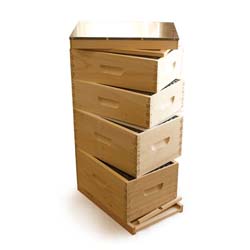This is similar to determining how long it takes for a honeybee to develop from an egg to an adult – it depends!
Worker Bees
Worker bees make up the majority of bees in a honeybee colony. They live for between 5-6 weeks and then die, having spent their entire lifetime working various jobs within the colony to help ensure their continued ability to reproduce and survive.
The jobs that a worker bee will focus on are dependent on where they are within their lifespan. For instance, younger bees that are just born will become nurse bees who care for other freshly hatched bees but more dangerous jobs like guarding and resource collection are reserved for older bees who are at the end of their life.
There are some exceptions to each bee’s average lifespan, of course, like winter bees who are born in the late fall, specially developed so they can survive for months during cold winter weather spemt inside their hive clustering (not hibernating) together to keep their queen safe and warm.
Drone Bees
Drones serve 1 main purpose inside a honeybee colony: to mate with the queen and ensure continued survival and genetic diversity of the honeybee colony. Their lifetime is a little longer than “summer” worker bees at around 2 months, but all drones’ lives will come to an end if they complete the process of mating with a queen. (See the Q&A linked above for more details on the drone’s role in honeybee reproduction) At the end of the fall months in colder climates, any drones remaining alive get kicked out of the colony and will perish regardless of where they are in their lifespan to ensure that they don’t consume unnecessary resources through the winter.
Queen Bees
The largest honeybee in a colony, the queen’s lifespan, duties, and anatomical makeup are entirely different from other types of honeybees. The queen’s main purpose is to lay eggs (up to 2000 per day from the start of the season) to help ensure the colony’s continued survival. Because of the royal jelly she’s fed during her development, the queen’s body is not only specially designed to lay eggs, but to withstand the test of time, too… queen honeybees live between 2 and 5 YEARS or more.
Though we don’t necessarily recommend this, some beekeepers choose to replace their queen at the start of each season to ensure she stays young, healthy, and laying throughout. As a honeybee queen ages, she runs out of stored sperm and will slowly lose her ability to lay eggs, slowing down and eventually stopping entirely. When that happens, a honeybee colony may sense the decline and decide to replace their queen themselves – this is called “supersedure”*.
(*Colony members, find the Academy lesson “Inspecting and Understanding the Brood Pattern” in the “Read More” section below to learn more about detecting signs of supersedure)
Read More
Honeybee Reproduction & Lifecycle
The Incredible Diversity of Bees
Inspecting and Understanding the Brood Pattern *
* Colony Member-Only Content
